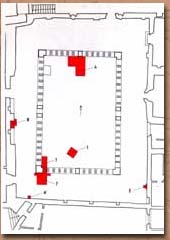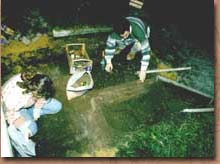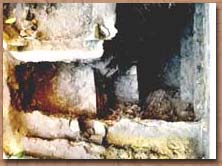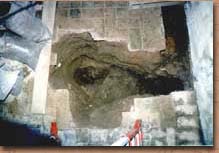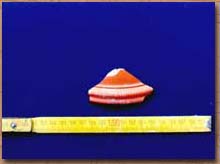Abstract of the archaeological survey
edited by Raffaele PuglieseSeveral excavations have been carried out in the cloister area with the aim of finding an answer to a variety of questions: from those concerning building transformations and structural composition to those relating to conservation issues. The results obtained so far have also given rise to useful new research opportunities. In survey no. 1, an ancient cistern, in which meteoric water still gathers to this day, was uncovered in the southern section of the garden. The cistern is on a quadrangular plan and was discovered for the first time by A. Muñoz who proceeded to empty it of the material that had been thrown into it over the years (ancient marble and ceramics) and then seal it off with a marble slab. Its depth is over 9 meters; its walls have been plastered in gray cement that is still in good condition.
In the extensive survey no. 4 within the garden area, traces of an earlier, perhaps late eighteenth century, garden plan have emerged along the north wall of small arches. A basin constructed with bricks covered with hydraulic mortar, a tract, again in brick, of an enclosure or path border and the recovery of a large ceramic container still in situ, used for planting flowers or other shrubs, all bear witness to this phase. The survey moreover revealed the building techniques adopted in the construction of the north wall of small arches that turns out to have been built with a facing of reused bricks covered with an intonaco that was probably painted. The foundations, of which two offsets have been identified, instead used ashlar blocks of tufa bedded with lime and pozzolanic mortar. At the southernmost point of the survey a tract of the foundations of the perimetral wall of Leo IV 's (847-855) basilica came to light and it is possible to observe how this took advantage of a Roman wall, probably of the later period, as its supporting base. Only a short tract of the latter was identified, sufficient however to illustrate its excellent workmanship. The wall is without doubt a valuable testimony of the complex underlying archaeological reality and can possibly be traced to one of the building structures forming part of the vast aristocratic domus that preceded the basilica. A possible link may exist between this case and what emerged from the survey carried out several years ago behind the chapel of Santa Barbara, where a tract of wall was discovered with back-to-back columns as its base. The typology could coincide with the one that we uncovered. If this hypothesis is confirmed by subsequent investigations, we may be confronted with the ruins of a huge portico structure, perhaps a peristyle, an ever-present element in the Roman domus. The south boundary wall of the Leo IV basilica is conserved up to about half a meter in height, but it is the same type of wall as that in the rest of the ninth century building: reused bricks laid in undulating courses with a particularly hard reddish mortar binding them together.
Surveys nos. 6 and 7 carried out along the perimeter walls of the south and east corridors, despite their lesser dimensions, have provided important information concerning both the existence of the different pavement phases and the static consistency of the structures as well as the humidity conditions of the terrain. After the removal of the paved floor and its base, it was ascertained that it lies on a loosely-packed layer of earth 5-10 cm deep, rich in archaeological material, mainly brick and ceramics. Among the ceramics other than those of Roman age (amphorae and terra sigillata), there are numerous fragments of tiles dating from the late sixteenth and early seventeenth century that provide a terminus post quem (starting point) for the pavement. Below this layer that was probably distributed uniformly over the whole area, the remains of other paving blocks were discovered. Whereas in survey no. 8, the block lies about 15 cm below the present pavement, in survey no. 6 it is at a much lower level of about 35 cm. This difference from the present level cannot be explained satisfactorily, although two hypotheses may be put forward: that these are levels relating to different periods or that a tract of corridor exists that is lower than the others.
A complex stratigraphy has instead emerged from survey no. 7 carried out in the south corridor of the cloister. It was noted that the south and west walls supporting the small arches have different characteristics from the north wall. Whereas the north wall has a gray and brown pozzolanic mortar, the binding material of the other two use red pozzolana and the mixture is much harder and tougher. This fact is certainly interesting as it would lead us to believe that either the materials came from different quarries or a pre-existing building preceded the third century cloister, and this would indeed represent a significant discovery.
The recovery inside
the garden of a rainwater drain running north-south that appears to have
been functioning up until the middle of the last century is of particular
interest in the study of the causes of humidity, both past and present.
It was constructed with one side against the west wall of small arches
and its other side against the ground and covered by bricks. Through a
cut at the base of the south wall of small arches, it was then connected
to another conduit at right angles. It is not clear as to whether the
two conduits are contemporary, even though it is probable that the north-south,
as opposed to the east-west one, was remade. The latter is 30 cm wide
and one side rests against the south wall of small arches while the other
side is embanked with reused bricks. Its base is paved in brick fragments
while various materials such as marble and brick have been used to cover
it including a sarcophagus fragment with spiral fluting. At the same time
as the drain there must be a pavement level in shattered brick bound with
not a very tough grayish-colored mortar. Below the present walking level
two floor surfaces have been identified. The deeper and more ancient was
discovered at about 40-42 cm below the present pavement resting on a layer
of brown earth that was almost devoid of archaeological material. The
floor is made up of a particularly hard and compact kind of ballast of
minute bricks and marble chips bound together with a lean mortar, and
then beaten and pounded, whose surface was covered with a thin layer of
slimy clay. The same technique was used in making the next floor at about
25-30 cm from the present pavement which, like the other, had a slimy
surface, perhaps resulting from wear or water infiltration that left a
deposit. The excavation clearly confirms the existence of several floor
levels, which despite being simply constructed with beaten earth, crocks
and broken bricks and bound with a lean mortar, were effective and easy
to maintain. In their present state it is difficult to put a date to these
pavement levels also because they are almost devoid of ceramic fragments,
but certain elements can be taken into consideration:
1) the most ancient
floor covers and marks the position of a wall, at right angles to the
existing ones and connected to a pavement in mashed brick, identified
at the end of the excavation and perhaps of Roman origin;
2) the earth
on which the brick pavement covering the east-west drain was laid contains
a lot of mid-sixteenth century ceramics that therefore provides an approximate
date for the construction of the drain;
3) the floors identified are at
a higher level than the foundations of the cloister wall. All this information
leads us to believe that the pavements discovered form part of the medieval
phases of the ambulatory of the cloister.
Introduction to the archeaological material
During the course of the excavations a considerable quantity of archaeological material has come to light, comprising marble, plaster, bones, and above all, numerous ceramic fragments. The high proportion of the latter in relation to the size of the excavations and their number, is an indication of the immense inherent cognitive potential within the stratigraphic reservoir represented by the cloister area. The chronological picture that the unearthed ceramics offers is vast: from Roman (amphorae and African sigillata) to Renaissance (with its polychrome productions for decoration or everyday use) up to modern (porcelain, Berettino enamel). The material is currently being catalogued and studied. Two specimen cards, relating to two chronologically and technically diverse archaeological finds that form part of this material, have been included (figg. 5 - 6)
|
© 1999 Coordination
Monica Morbidelli |
|
Fig. 1 - General plan of the cloister indicating where the surveys have been carried out.
Fig. 2 - Excavation IV of the basin US 15.
Fig. 3 - General view of excavation IV. To the left, the foundations of the cloister wall (US 24), to the right, the late Imperial wall (US 29) and above the foundations of the Carolingian basilica (US 22).
Fig. 4 - View of excavation VIII. To the right the late medieval drain (US 74); the white cards on the left side indicate the uncovered floor surfaces (US 82). The irregular borders of the excavation follow the ancient brick paving that had been replaced by a modern pavement in the excavated area.
Fig. 5 - Card n.38: terra african sigillata
Fig. 6 - Card n. 38: renaissance maiolica |
|
|
|
|
|
|
|
|
|
|
|
|
|
|
|
|
|
|
